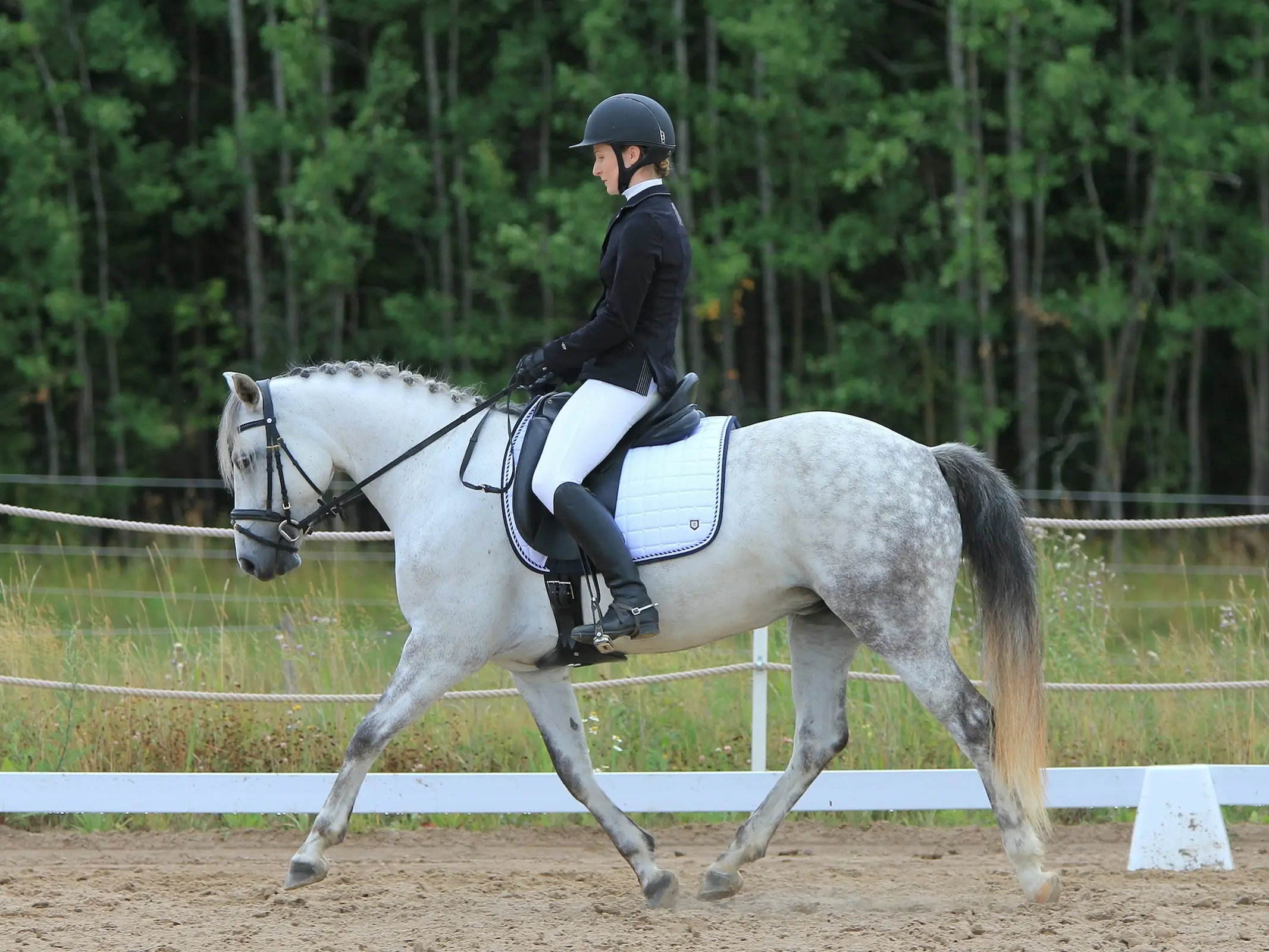
Above the bit
When a horse avoids accepting contact by pushing their muzzle forward and upward.
Activity
Liveliness and energy – generally referring to the hind legs.
Against the bit
When a horse avoids accepting contact by becoming unyielding in the neck, poll and/or jaw.
Airs / airs above the ground
Performed by horses specially trained in classical high school dressage, and includes pasade /levade and school jumps such as the courbette and capriole
Alignment
One of the three aspects of straightness, alignment is the lining up of the horses body from poll to tail.
Ask with the rein
A slight give and take on the rein to cue bend of flexion.
Balance
Distribution of weight of both horse and rider, the horse is to carry the bulk of both their own and the riders weight on the hindquarters not the forehand.
-Longitudinal balance – balance between fore and hind legs
-Lateral balance – balance between the left and right legs
Basics
The foundation of progressive dressage training and correctness is indicated by improvement.
The basics are:
1. Quality of paces and gaits
2. The physical and gymnastic abilities of the horse
3. The horses ride-ability and attitude
Beat
The patterned footfall of a gait when one or two hooves strike the ground almost simultaneously.
Behind the bit / behind the aids / behind the leg
When a horse avoids accepting contact by shrinking back from the bit and avoiding stepping forward into contact. Animal may or may not be behind the vertical.
Behind the vertical
When a horse avoids accepting contact by keeping their head tucked in a position behind a vertical line dropped down from their eye.
Bend
An arced position in which the horse creates an even curve with their body from poll to tail.
Blocked
Muscle contractions can create rigidity in horses which impairs function and elasticity.
Broken neckline
A neck position in which the topline does not form an even arc due to excessive flexion between either the 2nd and 3rd or 3rd and 4th cervical vertebrae.
Cadence
An accentuation of tempo and beat which arises from extreme springiness and elasticity.
Camped
When the hind legs are placed behind the horses body and not engaged underneath.
Carriage
The horses posture, best viewedi in a confirmation shot, or from one side of the horse.
Chewing the bit
When a horse mouths or plays with their bit, creating a steady stream of foamy saliva.
Clarity
Strong distinction between the footfalls of a gait.
Closed halt
A halted posture in which the horse is well balanced with it’s hind legs engaged under the body.
Collected / collection
A horse can be collected at the walk, trot and canter. It is a moving state in which a horses stride is gathered and powerful. Strides are shorter, and springier and front legs tend to reach higher with each step.
Confidence
The level of a horses confidence in themselves and their partnership with their rider.
Connection
The unrestricted flow of energy, trust and respect between horse and rider as partners.
Constrained
When a horse is forced into an action against its will.
Constricted
When a horse is forcefully constrained, restrained or contracted.
Contact
Tautness of the reins between the riders hands and the horses mouth.
Correctness
The straightness of limb action
*This is not the same as purity and is only dealt with by dressage judges if it directly affects the purity of a gait.
Breeding class judges do judge correctness.
Crookedness
1. An off-center line of travel or line of reference.
2. When the horses body from tail to poll is misaligned
3. A lack of directness in line of travel
Cross-canter
When a horse canters with one lead in front and the other lead behind.
Disobedience
When a horse does not do or willfully avoids doing what it is asked of it.
Dragging
When a horse drags their hind feet or their hind legs become inactive.
Elasticity
The natural ability to stretch and contract muscles smoothly giving an impression of springy movement.
Elevation
1. The free raising of the head and neck from lifted withers
2. The height which the forelegs are raised in passage and piaffe
Engagement
Increased flexion of the hind leg joints during the weight-bearing phase of a stride which lowers the croup relative to the forehand.
*It does not refer to the flexion of hock action (like that of gaited horses).
Evasion
A horses way of avoiding direct and workable contact with the bit.
Expression cadence / extended / extension
A horse can be extended at the walk, trot or canter, and it refers to a lengthening and stretching of the stride (and an increased suspended phase at the trot and canter).
I have a horse-trainer/center “lingo” question.
I am a North American
Riding for the Handicapped Assoc, Inc instructor-in-training.
(N.A.R.H.A.).
I am helping to form a riding center and I designate duties
to our volunteers. I don’t remember the “proper” lingo for
the person who “pulls” the horses (goes to assigned horse
and stall and places halter/leads horse to groomer.) How do
you or others refer to that designated person?
Thanks,
Lisa Coker
Hi Lisa,
I’d call them a handler (I’m not sure how *proper* it is), although I imagine that what you described could also fall under a groom duties. Here is a list of horse jobs if it helps. Let me know what you decide. 🙂
Flying-Change, Shoulder-In?